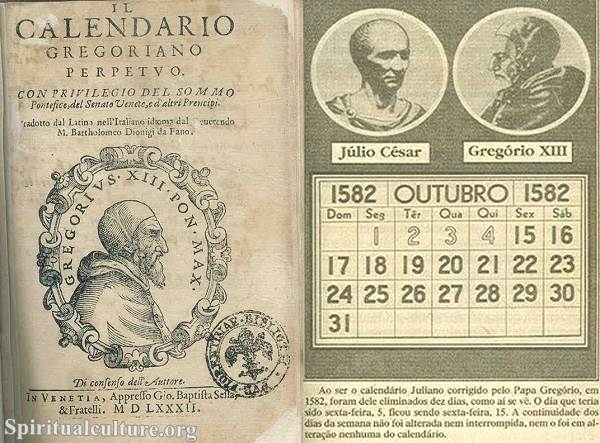The distinction between the Julian calendar and the Gregorian calendar offers a captivating look into how humanity has sought to measure and understand time throughout history. This exploration is not merely academic; it involves deep historical, cultural, and astronomical considerations, illustrating the evolution of timekeeping from ancient Rome to the modern world.

In this article, Spiritual Culture delves into the origins, structures, key differences, conversion methods, and the significance of each calendar in today’s context, ultimately demonstrating how our understanding of time shapes and reflects our civilization.
Historical Background of the Julian Calendar
Introduction of the Julian Calendar by Julius Caesar
The Julian calendar was introduced in 46 BC by Julius Caesar, a reform aiming to address the inadequacies of the Roman calendar. Prior to this reform, the Roman calendar was a complex lunisolar system, which attempted to reconcile the cycles of the moon with those of the sun. This calendar system was riddled with inconsistencies; it typically had only 355 days in a year, interspersed with 22- or 23-day intercalary months added by priests to realign the calendar with the seasons.
This method resulted in significant drift, causing the calendar to become increasingly out of sync with the agricultural and seasonal cycles that were crucial for Roman society. The alignment of days with seasonal weather patterns influenced harvests, religious festivals, and civic events. Recognizing the need for reform to support effective governance and agricultural planning, Caesar turned to the astronomer Sosigenes of Alexandria for advice.
Under Sosigenes’s guidance, Caesar established a year comprising 365 days, divided into 12 months, with a leap year system that added an extra day to February every four years. This reform led to the creation of the Julian calendar, which stabilized the measurement of time for centuries and improved the synchronization of civic life with natural cycles.
Structure and Features of the Julian Calendar
The Julian calendar features a structured layout of 12 months with a total of 365 days, which creates a simpler and more intuitive system compared to its predecessor. The months are allocated as follows:
- January: 31 days
- February: 28 days (29 in leap years)
- March: 31 days
- April: 30 days
- May: 31 days
- June: 30 days
- July (originally Quintilis, later renamed): 31 days
- August (originally Sextilis, later renamed): 31 days
- September: 30 days
- October: 31 days
- November: 30 days
- December: 31 days
One of the unique aspects of the Julian calendar is its leap year mechanism, designed to accommodate the extra quarter day that the solar year exceeds the 365-day cycle. Every four years, February gains an additional day, which helps keep the calendar in closer alignment with the astronomical year.
However, this system only provides a medium level of solar accuracy. On average, the Julian year is 365.25 days long, resulting in an accumulating error. The solar year is approximately 365.2422 days long, leading to a drift of about one day every 128 years—a discrepancy that would eventually necessitate further reform.
Adoption and Usage of the Julian Calendar
The Julian calendar was quickly adopted throughout the Roman Empire and established a standardized measure of time that influenced not only civic life but also religious observances. As the Roman Empire expanded, its calendar system spread to many conquered territories, embedding itself in various cultures and legal systems.
Despite its wide usage, the inaccuracies in the Julian calendar gradually became apparent. By the Middle Ages, the cumulative error attributable to the Julian calendar became increasingly problematic, particularly for churches in determining the dates of religious observances, especially Easter. Easter is based on a lunisolar calendar, which significantly complicates its observance when misalignments occur with the seasons. By the 16th century, the calendar had drifted roughly 10 days behind the solar year, leading to calls for reform.
Historical Background of the Gregorian Calendar
Reform of the Calendar by Pope Gregory XIII
To address the significant misalignment of the Julian calendar with the solar year, Pope Gregory XIII commissioned a new calendar reform in 1582. The goal was to realign the calendar to ensure that key dates in the Christian calendar, particularly Easter, remained consistent with the spring equinox.
The Gregorian calendar reform involved two main actions: adjusting the number of leap years and the immediate retraction of ten days from the calendar. The new system was implemented by decreeing that the day after October 4, 1582, would be October 15, effectively skipping ten days. This immediate correction was crucial in realigning the calendar with the equinox.
Structure and Features of the Gregorian Calendar
The structure of the Gregorian calendar is similar to that of the Julian calendar, comprising twelve months and totaling 365 days. However, it introduces important modifications to the leap year system:
- Leap Year Criteria:
- A year is a leap year if it is divisible by 4.
- However, if the year is divisible by 100, it is not a leap year, unless it is also divisible by 400.
For example:
– The years 1600 and 2000 were leap years.
– The year 1900, however, was not a leap year.
This adjustment results in a more precise average year length of approximately 365.2425 days, significantly reducing drift over millennia and aligning the calendar with the actual solar year.
Adoption of the Gregorian Calendar Worldwide
The adoption of the Gregorian calendar was uneven across Europe and the world. Initially embraced by Catholic countries, such as Spain, Portugal, and Italy, in 1582, it faced resistance in Protestant regions. In Britain and its colonies, for instance, the switch to the Gregorian calendar did not occur until 1752. By then, the difference between the Julian and Gregorian calendars had increased to 11 days.
Different nations adopted the Gregorian calendar over the subsequent centuries. Greece was among the last European nations to make the switch in 1923, while some cultures and communities that had their traditional calendars retained them for religious and cultural reasons.
Key Differences Between the Julian and Gregorian Calendars
Leap Year Calculations
The leap year calculations between the two calendars represent one of their most significant distinctions. In the Julian calendar, a leap year occurs every four years without exception. This simplicity makes the system easy to understand for casual users but results in cumulative inaccuracy.
In contrast, the Gregorian calendar refines this system, allowing leap years but only under specific conditions. This more complex approach allows for greater precision, minimizing discrepancies over extended periods. As a result, while the Julian calendar averages a year length of 365.25 days, the Gregorian calendar averages 365.2425 days, aligning more accurately with the solar year.
Average Year Length Comparison
The discrepancies in year length between the Julian and Gregorian calendars have profound implications for timekeeping. The Julian calendar’s year length fosters an accumulating error, placing the Julian calendar approximately 1 day behind the solar calendar every 128 years. For example, over the span of 1,600 years, this leads to a drift of around 12 days.
Conversely, the Gregorian calendar’s reforms lead to a scenario where its drift is only about 1 day every 3,030 years. This increased level of astronomical accuracy is crucial for various aspects of society, especially agriculture and religious observances, where timing can significantly affect outcomes.
Astronomical Accuracy and Drift
The Gregorian calendar has significantly improved astronomical accuracy compared to the Julian calendar. Its calibration to the solar year allows for a more reliable and consistent framework for mapping seasonal cycles. This precision has ramifications across agricultural practices, facilitating better planning for planting and harvesting.
Furthermore, maintaining astronomical accuracy is particularly important for organizing religious events. Over centuries, Easter has drifted in the Julian calendar, leading to misunderstandings and dissatisfaction among Christian congregations. The Gregorian reform sought to stabilize this practice, ensuring the celebration of Easter reflects its intended timing relative to the spring equinox.
Conversion Between Julian and Gregorian Calendars
Methods for Date Conversion
Converting dates between the Julian and Gregorian calendars requires a systematic approach to account for the difference in the number of days. For any date after October 4, 1582, when the Gregorian calendar was adopted, you typically add 10 days to convert from Julian to Gregorian until about the year 2100. After this date, you will need to consider that additional one-day drift in terms of leap year adjustments when converting.
For instance, to convert any Julian date to its Gregorian equivalent, you can employ the general rule:
- For dates from October 1582 onwards, add 10 days.
- As of 1900, the difference grows to 13 days (by then, 3 additional days of drift due to leap year discrepancies).
- After 2100, it will be consistently 14 days.
Examples of Date Conversions
For practical illustrations:
– Conversion Example 1: January 1, 1900 (Julian)
– Adding 13 days gives: January 14, 1900 (Gregorian).
- Conversion Example 2: April 1, 2023 (Julian)
- Adding 14 days gives: April 15, 2023 (Gregorian).
- Conversion Example 3: December 25, 2024 (Julian)
- Adding 14 days gives: January 7, 2025 (Gregorian), illustrating the impact of cultural observances, such as Orthodox Christmas celebrations.
Implications of Calendar Conversion
This conversion system is critical for scholars and historians who aim to align historical events accurately between the two calendars. Misalignment can lead to significant discrepancies in the historical record.
Understanding conversions also assists in coordinating events across cultures, particularly in our increasingly globalized world. Knowledge of how dates change in different traditions informs scheduling for international conferences, religious observances, and cultural festivals—ensuring respectful engagement among diverse communities.
Calendar Misalignment Issues
Historical Misalignment and Its Effects
Historical misalignments between the Julian and Gregorian calendars have had wide-ranging repercussions throughout societies. The immediate consequences were seen in the stabilization of the Catholic Church’s calendar, which was hampered by the drift of the Julian system. As the Christian Church sought a unified calendar for holy observances, discrepancies caused frustration and confusion.
Various countries also faced challenges in trade and communications due to differing calendars. This led to misunderstandings and logistics complications as neighboring regions operated on different time systems, leading to social and political frictions.
Future Predictions for Calendar Drift
Looking ahead, while the Gregorian calendar is significantly more accurate than the Julian, it is not error-free. Discussions among astronomers suggest that there may be emerging needs to further refine leap year rules to address the remaining inaccuracies.
In the long-term perspective, predictions indicate that the Gregorian calendar’s drift of one day every 3,030 years could become problematic, particularly for astronomical calculations and long-term planning. As timekeeping methods continue to evolve with scientific advancements, such discussions are likely to remain on the agenda for scientists and policy-makers.
Cultural Impact of Calendar Systems
The existence of different calendar systems and their associated misalignments influence societies culturally and spiritually. Calendar systems are integral to religious observances, impacting how communities celebrate significant events, such as holidays and festivals. Cultures that adhere to the Julian calendar maintain traditions that may differ from those influenced by the Gregorian system, creating a rich tapestry of beliefs and practices.
For example, Orthodox Christian communities that continue to adhere to the Julian calendar celebrate Christmas on January 7, diverging from the Gregorian celebration on December 25. This can lead to a diverse array of observances that deepen cultural identities and distinctions.
Modern Relevance of Julian and Gregorian Calendars
Current Use of the Julian Calendar
Despite the dominance of the Gregorian calendar, the Julian calendar is still employed by some Orthodox Christian communities for religious purposes. This enduring usage reflects not only historical fidelity but also cultural identity. Many of these communities celebrate key religious events based on Julian dates, resulting in differences in the timing of these celebrations compared to those who follow the Gregorian calendar.
Religious leaders in these communities continue to uphold traditional observances that encapsulate their cultural and spiritual heritage, illustrating the significance of the Julian system in maintaining identity and continuity.
Dominance of the Gregorian Calendar in Global Contexts
The Gregorian calendar dominates global contexts, functioning as the standard for international interactions, commerce, and diplomacy. Its widespread adoption facilitates global scheduling and allows for uniformity in planning across nations and cultures. This standardization is crucial for modern economies that heavily rely on consistent timekeeping for business operations, trade agreements, and international collaborations.
Globally recognized events, such as New Year’s celebrations, are organized based on the Gregorian calendar, creating shared cultural experiences among diverse populations despite their varied historical backgrounds.
Impact on Religious Practices and Observances
The differences in calendar systems have marked effects on religious practices within Christianity. The determination of key dates, such as Easter, varies significantly based on the calendar followed. This divergence has implications not only for scheduling but also for intra-community relations.
In an effort to address differences, discussions of unifying practices among Christian denominations continue, with varying opinions on the merits of adhering to either calendar.
Comparison of Leap Year Rules
Detailed Analysis of Leap Year Criteria
The leap year rules present a fascinating exploration of how societies opt for timekeeping mechanisms that meet their needs. In the case of the Julian calendar, while its simplicity was advantageous in the short term, its long-term consequences led to the realization that greater precision was necessary.
The Gregorian leap year rules reflect an understanding influenced by a blend of astronomy and practicality. By carefully detailing conditions for leap years, it aligns better with solar and seasonal reality, fostering a calendar that reaffirms the connection between natural cycles and human activities.
Effects on Seasonal Alignment
The accuracy of leap year criteria has significant implications for seasonal alignment. With the Gregorian calendar’s improved structure, festivals and planting seasons can maintain their expected alignment without the shift that occurs over time with less precise systems. This not only aids individual planning in agricultural and religious activities but has broader implications for national policies related to agriculture and education.
Case Studies of Calendar Implementation
Historical Case Studies in Different Countries
The implementation of these calendar systems across various countries illustrates the complexity of cultural and political acceptance. In France, the revolutionary calendar was briefly adopted post-1789 as an attempt to rationalize time while promoting revolutionary values. This calendar created an entirely new system but faced significant backlash and was ultimately discontinued.
Countries like Russia experienced a chaotic transition when adopting the Gregorian calendar in 1918. The October Revolution in 1917 took place on what was then October 25 in the Julian calendar, yet it was referred to as the October Revolution, despite this discrepancy later leading to confusion.
Reactions to Calendar Changes
Reaction to changes in calendars often oscillates between enthusiasm for modernization and resistance rooted in tradition. For instance, Britain’s prolonged use of the Julian calendar reflected a cultural attachment to established practices, ultimately leading to confusion and frustration with international dealings.
In some instances, resistance has manifested as social commentary or artistic expressions that criticize the bureaucratic and political ramifications of calendar adjustments. Countries that adopted the Gregorian calendar had to contend with societal disruption, leading to conflicts between traditionalists and modernizers who envisioned a reformed future.
Future of Calendar Systems
Proposed Reforms for Improved Accuracy
As our understanding of astronomy and timekeeping evolves, proposals for enhancing calendar systems emerge. Concepts such as a decimal calendar—suggested by early 20th-century thinkers—aim to streamline timekeeping but have yet to garner widespread support. This conceptualization would seek to simplify the measurement of time while accommodating the realities of our solar system’s cycles.
Additionally, discussions about digital timekeeping methods in a technological age have gained traction. Digital calendars allow for greater flexibility and adaptability for calculating leap seconds and managing time zones, addressing specific needs of modern society that historical methods have struggled to accommodate.
Discussions in Academic and Scientific Circles
Discussions about the future of calendar systems often transcend academic study, reflecting societal priorities in relation to time. Scholars are increasingly drawn to the relationship between calendars and cultural identity, exploring how different systems shape societal norms and values globally.
Academics also discuss the possibility of universal timekeeping systems to facilitate international cooperation, especially in our globalized environment where communication is instantaneous. The challenge lies in integrating diverse cultural perspectives while creating a system that honors historical and religious significance.
Conclusion on Calendar Evolution
Summary of Findings
The evolution from the Julian calendar to the Gregorian calendar encapsulates humanity’s enduring quest for timekeeping accuracy. Through this journey, we have witnessed the emergence of structured systems that reflect not only astronomical knowledge but also cultural values and historical legacies.
The contrast between the two calendars highlights the significance of aligning our temporal frameworks with natural cycles. The Gregorian calendar not only offers greater precision but also embodies a consensus on the importance of timekeeping for societal cohesiveness in an interconnected world.
Importance of Accurate Timekeeping
Accurate timekeeping serves essential functions in modern life. From agriculture and religious observances to international diplomacy and economic transactions, calendars profoundly influence how we experience and understand the passage of time. The ongoing legacy of the Julian and Gregorian calendars underscores the interplay between culture, science, and faith in shaping identifiable human progress throughout history.
Looking to the future, societies will undoubtedly continue to explore new methods of timekeeping that enhance accuracy while accommodating the diverse perspectives and traditions that enrich our understanding of time. As we embrace change, it is vital to remember the lessons of history while ensuring that our timekeeping systems reflect the shared human experience in all its complexity.
As humanity continues to evolve and adapt, the quest for precision in measuring time remains a testament to our enduring desire to understand our place within the universe, to navigate our lives effectively, and to mark the important events that shape our collective journey. Through calendars, we maintain a connection to our past while paving the way for future generations to experience and understand time in ways that reflect their values, beliefs, and aspirations.


